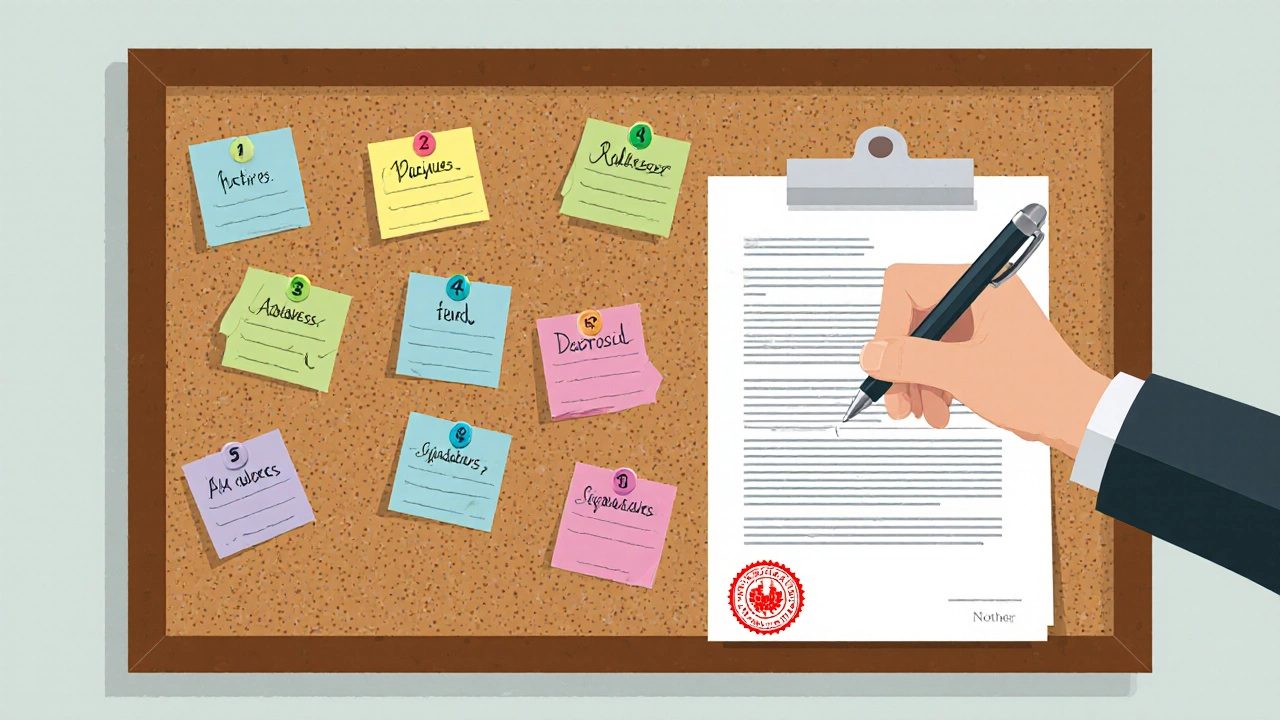Handwritten Lease Validity Checker
Check Your Lease Compliance
Enter the key elements of your handwritten rental agreement to see if it meets legal requirements for enforceability. This tool checks for essential elements required by most U.S. state laws.
When you’re renting a house, the first thing you want is a paper that proves the terms you and your landlord agree on. But does a simple pen‑and‑paper document hold up in court? The short answer is yes - a handwritten rental agreement can be perfectly legal, as long as it meets a few key requirements. Below we break down exactly what makes a lease enforceable, when a handwritten note qualifies, and how to avoid costly mistakes.
What Makes Any Rental Agreement Enforceable?
At its core, a rental contract is just a lease agreement a legally binding promise between a landlord and a tenant that outlines rent, duration, and responsibilities. For any contract to be enforceable, three elements must be present:
- Offer and acceptance - one party proposes terms, the other agrees.
- Consideration - something of value (usually rent money) is exchanged.
- Capacity and legality - both parties must be competent adults, and the agreement can’t require illegal actions.
If these basics are satisfied, the contract is generally valid, whether it’s typed, printed, or scribbled.
Statute of Frauds: Does the Law Require a Typed Document?
The biggest myth is that the law forces every lease to be typed or digitally signed. In reality, most U.S. states have a “Statute of Frauds” that simply demands certain contracts be in writing - not in any particular font.
For residential leases longer than one year, the Statute of Frauds a legal doctrine requiring certain agreements to be in written form to be enforceable applies. A handwritten note qualifies as a written document, as long as it includes the essential terms (rent amount, address, parties, and duration).
When Does a Handwritten Document Satisfy the Law?
Courts look for clarity. A handwritten lease is enforceable if it:
- Clearly identifies the landlord the property owner who rents out the space and the tenant the person who will occupy the rental unit.
- Specifies the rental address.
- States the monthly rent and payment date.
- Lists the lease term (start and end dates).
- Includes signatures from both parties, dated.
Anything vague - “rent reasonable” or “stay for a while” - can be challenged. Even a single‑page note can survive court scrutiny if it ticks these boxes.

Handwritten vs. Typed vs. E‑Signature: A Quick Comparison
| Feature | Handwritten | Typed/Printed | E‑Signature |
|---|---|---|---|
| Legality | Legal if all elements are present | Legal; easier to read | Legal under ESIGN Act (U.S.) |
| Clarity | Can be hard to read | Clear, standard formatting | Digital audit trail |
| Amendments | Often require full rewrite | Can use addendums | Simple electronic versioning |
| Proof of authenticity | May need notarization | Signatures suffice | Timestamped logs |
| Cost | Minimal (pen & paper) | Printing/printing fees | Software subscription |
Notice that there’s no legal superiority - the choice is about practicality and evidence. If you go handwritten, consider adding a notarization the act of a notary public certifying the authenticity of signatures step for extra protection.
Common Pitfalls and How to Protect Yourself
Even a well‑written handwritten lease can fall apart if you ignore these traps:
- Illegible handwriting - If a judge can’t read the terms, they may deem the contract invalid.
- Missing signatures - Both parties must sign; a missing tenant signature is a deal‑breaker.
- Omitting essential clauses - Include security deposit rules, maintenance responsibilities, and early‑termination fees.
- State‑specific requirements - Some states, like California, require disclosures about lead‑based paint or habitability standards.
To safeguard yourself, keep a photocopy of the signed page, note the date of signing, and, if possible, have a neutral witness sign as well.

Step‑by‑Step Guide to Drafting a Legally Solid Handwritten Lease
- Gather basic information: full legal names, address of the rental property, and contact details.
- Write the heading: "Residential Lease Agreement" at the top.
- List the term: "Lease starts on ___ and ends on ___".
- State the rent amount, due date, and acceptable payment methods.
- Detail security deposit: amount, conditions for return, and any deductions.
- Include upkeep duties: who fixes what, who pays utilities.
- Add any state‑required disclosures (e.g., mold, pest control).
- Reserve space for both parties’ signatures and the date.
- Review for legibility; consider typing the final version and having each party sign the printed copy if handwriting is poor.
- Optional: visit a notary public to notarize the signatures for added credibility.
Following these steps gives you a clear, enforceable document that a court will recognize.
Frequently Asked Questions
Can a landlord refuse a handwritten lease?
Yes. While the law doesn’t prohibit handwritten leases, a landlord may prefer a printed or digital version for readability and record‑keeping. If they refuse, you can still negotiate and ask them to type up the same terms.
Do I need a notary for a handwritten lease?
Not usually. A notarization isn’t required for most residential leases, but it adds an extra layer of proof if the agreement is ever contested.
What if my lease is longer than one year?
Leases over twelve months fall under the Statute of Frauds in every state, meaning the agreement must be in writing. Handwritten still counts as writing, provided all essential terms are included.
Can I switch from a handwritten lease to an electronic one later?
Absolutely. Both parties can sign a new e‑signed amendment that references the original handwritten contract. Just keep copies of both documents.
What state‑specific rules should I watch out for?
Each state has its own landlord‑tenant code. For example, California requires a "habitability" clause, while New York mandates disclosure of any illegal occupants. Look up your state’s rental law the body of statutes governing landlord‑tenant relationships before finalizing the lease.
Bottom line: a neatly written, signed lease that covers the basics is just as enforceable as a fancy printed contract. Use the checklist above, keep a clear copy, and you’ll have peace of mind for the whole tenancy.

